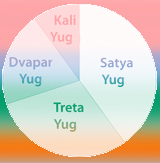Devas
In Hinduism, Devas are celestial beings considered divine and benevolent, inhabiting higher realms of existence. The term “Deva” is rooted in the Sanskrit word “div,” meaning to shine or illuminate, symbolizing the luminous and virtuous nature associated with these celestial entities. In Hindu mythology, Devas are celestial beings or gods who inhabit the heavenly realms […]
Asurs
In Hindu mythology, Asuras are a group of supernatural beings or demigods, often depicted as powerful, malevolent forces in contrast to the benevolent and virtuous Devas. The Devas and Asuras are two distinct groups of celestial beings that play significant roles in various mythological narratives. The term “Asura” is derived from the Sanskrit root “asu,” […]
Why Lord Shiv is called Devo ke Dev : “Mahadev”?
The title “Mahadev” is one of the many names and epithets associated with Lord Shiv in Hinduism. The term “Mahadev” is a Sanskrit compound word, where “Maha” means great or supreme, and “Dev” refers to deity or god. Therefore, “Mahadev” can be translated to mean “Great God” or “Supreme Deity.” Several factors contribute to Lord […]
How did Nandi become the vehicle of Lord Shiv?
The association of Nandi, the divine bull, as the vehicle (vahana) of Lord Shiv is rooted in Hindu mythology and has several narratives associated with it. Devotees often seek the blessings of Nandi before approaching Lord Shiv, considering Nandi’s role as a gatekeeper and a symbol of devotion. While there are variations in the stories […]
Sacred Bull of Lord Shiv : Nandi
Nandi, which means “giving delight” or “giving joy,” is the sacred bull of the Hindu god Shiv, one of the most important Hindu gods. When the world becomes evil, Shiv destroys it to make way for beneficial change. Nandi is Shiv’s animal form, his means of transportation, and his most ardent worshiper. Nandi is a prominent […]
Kaliyug

Kali Yug is the fourth and final age in the cycle of Yugs, as described in Hindu cosmology. It follows Satya Yug, Treta Yug, and Dvapar Yug. Kali Yug is characterized by a significant decline in righteousness (dharma) and an increase in unrighteousness. It is considered the age of darkness, conflict, and spiritual degeneration. […]
Dvaparyug

Dvapar Yug is the third of the four Yugas or ages in Hindu cosmology, following Satya Yug and Treta Yug and preceding Kali Yug. Even before the beginning of Dvapar Yug, by the end of Treta Yug, human beings began to stray from the path of dharm, or the religious way of life. Dvapar Yug is […]